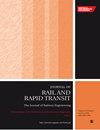Towards time-domain modelling of wheel/rail noise: Effect of the dynamic track model
IF 2.1
4区 工程技术
Q3 ENGINEERING, CIVIL
Proceedings of the Institution of Mechanical Engineers Part F-Journal of Rail and Rapid Transit
Pub Date : 2023-06-06
DOI:10.1177/09544097231179514
引用次数: 0
Abstract
Transient events in railway rolling noise, such as the characteristic impulsive noise at switches and crossings, can significantly contribute to the perceived annoyance, despite being difficult to detect in the standard frequency-domain methods to analyse rolling noise. Studying these transient effects and their perception requires predicting the noise in the time domain. While several time-domain approaches exist for predicting the dynamic interaction of wheel and rail, predicting the associated rolling noise with adequate accuracy is computationally costly. The lack of a model for transient noise and the need for studying its perception was recently identified. Aiming for a comprehensive time-domain radiation model that includes the wheel and track contributions to rolling noise, this work focuses on the track radiation. The modelling approach taken here is based on a 2.5D formulation for the acoustic radiation and moving Green’s functions in the air. The computational cost, which lies mainly in the 2.5D BE calculations, is addressed by pre-calculating acoustic transfer functions. These transfer functions can be combined with different dynamic track models. Different dynamic track models in turn affect radiated sound field in different ways. Here, the sound fields produced by six different track models are compared, including different support types and analytical and numerical rail models. Several descriptors of the sound field are analysed. In terms of the radiated sound power and radiation efficiency, modelling the rail as a simple beam leads to similar results as elaborate numerical models up to about 5 kHz. In terms of the track-side sound pressure, simple beam models can provide similar results only up to 2.5 kHz. Euler-Bernoulli (E-B) beams seem unfit for time-domain predictions of the radiated noise as they over-estimate the bending wave speed at high frequencies. The results also show that the standard track decay rate (TDR) and the decay of acoustic sound pressure along the track are comparable.轮轨噪声的时域建模:动态轨道模型的影响
铁路滚动噪声中的瞬态事件,如道岔和交叉路口的特征脉冲噪声,可以显著地促进感知烦恼,尽管在分析滚动噪声的标准频域方法中很难检测到。研究这些瞬态效应及其感知需要在时域内预测噪声。虽然有几种时域方法可用于预测轮轨的动态相互作用,但准确预测相关的滚动噪声在计算上是昂贵的。最近发现了瞬态噪声模型的缺乏和研究其感知的需要。为了建立一个包括车轮和轨道对滚动噪声贡献的综合时域辐射模型,本文重点研究了轨道辐射。这里采用的建模方法是基于声辐射的2.5D公式和空气中的移动格林函数。计算成本主要体现在2.5D BE计算中,通过预先计算声学传递函数来解决。这些传递函数可以与不同的动态轨迹模型相结合。不同的动态轨迹模型反过来又以不同的方式影响辐射声场。本文对六种不同轨道模型的声场进行了比较,包括不同的支撑形式、解析轨道模型和数值轨道模型。分析了声场的几种描述符。在辐射声功率和辐射效率方面,将轨道建模为一个简单的光束,结果与精细的数值模型相似,最高可达5 kHz。在轨道侧声压方面,简单的波束模型只能提供2.5 kHz的类似结果。由于欧拉-伯努利(E-B)波束过高估计了高频弯曲波的速度,因此似乎不适合用于辐射噪声的时域预测。结果还表明,标准轨道衰减率(TDR)和声压沿轨道衰减具有可比性。
本文章由计算机程序翻译,如有差异,请以英文原文为准。
求助全文
约1分钟内获得全文
求助全文
来源期刊

CiteScore
4.80
自引率
10.00%
发文量
91
审稿时长
7 months
期刊介绍:
The Journal of Rail and Rapid Transit is devoted to engineering in its widest interpretation applicable to rail and rapid transit. The Journal aims to promote sharing of technical knowledge, ideas and experience between engineers and researchers working in the railway field.
 求助内容:
求助内容: 应助结果提醒方式:
应助结果提醒方式:


